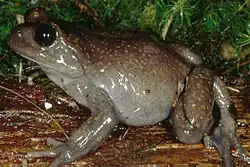Telmatobius atahualpai
| Telmatobius atahualpai | |
|---|---|

| |
| Scientific classification | |
| Kingdom: | Animalia |
| Phylum: | Chordata |
| Class: | Amphibia |
| Order: | Anura |
| Family: | Telmatobiidae |
| Genus: | Telmatobius |
| Species: | T. atahualpai
|
| Binomial name | |
| Telmatobius atahualpai Wiens, 1993
| |
Telmatobius atahualpai (common name: Amazonas water frog) is a species of frog in the family Telmatobiidae. It is endemic to the Cordillera Central of northern Peru and found in the San Martín and Amazonas Regions at 2,600–4,000 m (8,500–13,100 ft) asl.[2][3]
Description
The skin of the dorsum is black with green flecks. The belly is gray. Some of its teeth resemble fangs.[3]
Habitat
This semi-riparian frog is found in streams in forest and páramo habitats. It has been found under rocks in the water and on the forest floor.[1]
Scientists have found the frog in one protected area: Río Abiseo National Park.[1]
Relationship to humans
Human beings harvest other frogs in Telmatobius for food and medicine. Scientists think people may do the same with T. truebae.[1]
Young
This frog reproduces in streams. Scientists observed tadpoles in fast-moving water. These are the most highly specialized tadpoles in the genus reported as of 2017.[1]
Threats
The IUCN classifies this frog as vulnerable to extinction. Its threats include intensive livestock farming, associated pollution, and fires. Scientists believe the fungal disease chytridiomycosis may pose a threat to this frog because it has killed other frogs in the area, but they have not yet reported the Batrachochytrium dendrobatidis fungus on individuals of this species.[1]
Original publication
- Wiens, J.J. (1993). "Systematics of the leptodactylid frog genus Telmatobius in the Andes of northern Peru. Occ". Papers of the Museum of Natural History, University of Kansas. 162: 1–76.
References
- ^ a b c d e f IUCN SSC Amphibian Specialist Group (2017). "Telmatobius atahualpai". IUCN Red List of Threatened Species. 2017: e.T57325A89213199. doi:10.2305/IUCN.UK.2017-3.RLTS.T57325A89213199.en. Retrieved 17 November 2021.
- ^ Frost, Darrel R. (2014). "Telmatobius atahualpai Wiens, 1993". Amphibian Species of the World: an Online Reference. Version 6.0. American Museum of Natural History. Retrieved 6 April 2014.
- ^ a b Raul E. Diaz (August 27, 2004). Tate Tunstall (ed.). "Telmatobius truebae Wiens, 1993". AmphibiaWeb. University of California, Berkeley. Retrieved August 12, 2025.
